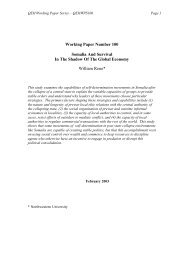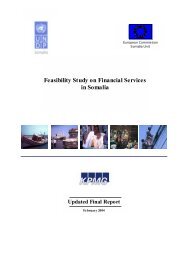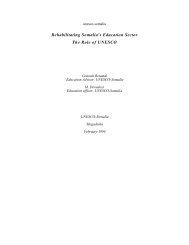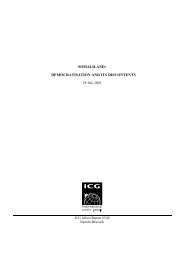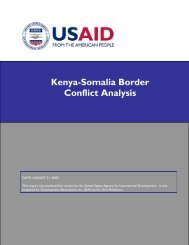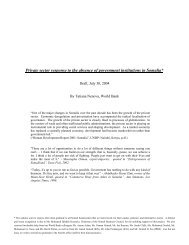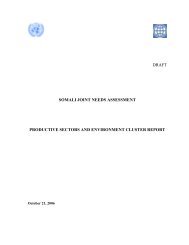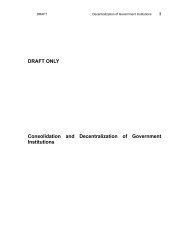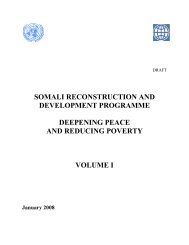Primary Education Survey Evaluation Report Somalia - Somali - JNA
Primary Education Survey Evaluation Report Somalia - Somali - JNA
Primary Education Survey Evaluation Report Somalia - Somali - JNA
You also want an ePaper? Increase the reach of your titles
YUMPU automatically turns print PDFs into web optimized ePapers that Google loves.
PES <strong>Evaluation</strong> <strong>Report</strong>, 2008<br />
Table 1: EFA Indicators not <strong>Report</strong>ed<br />
ECD 1 Gross enrolment ratio in Early Childhood Development (ECD) 1<br />
G1ECD 2 Percentage of new entrants to Grade 1 with ECD experience<br />
AIR-NIR 3, 4 Apparent Intake rates (AIR) and Net Intake rate (NIR) in primary<br />
education 2<br />
NER 6 Net Enrolment ratios (NER) in primary education<br />
EXP 7<br />
8<br />
a) Public current expenditure on primary education as a % of GNP 3<br />
b) Public current expenditure per pupil on primary education as a % of<br />
GNP per capita; and Public current expenditure on primary education as a<br />
% of total public current expenditure on education.<br />
REPETITION 12 Repetition rates by grade in primary education<br />
SURVIVAL 13 Survival rate to grade 5 4<br />
14 Coefficient of efficiency at grade 5 and at the final grade 5<br />
ACHIEVEMENT 15 % of pupils who master basic learning competencies<br />
LITERACY 16, 17 Adult Literacy rates 15-24 years and 15 years and over<br />
18 Literacy Gender Parity Index (GPI)<br />
Note. Current gender indicators are proxies for standard gender parity index due to lack of age cohort<br />
data.<br />
With the exception of the proxy for the survival rate, no outcome data is reported that would allow us to<br />
make judgements with regard to the quality of the education process. One Zone shared their examination<br />
system process and the data collection system associated with it. The system has the potential to provide<br />
information with regard to the “% of pupils who master basic learning competencies” provided suitable<br />
forms of examination data analysis were undertaken. Unfortunately, this examination data was not linked<br />
to the PES. In fact a parallel data base was being established reflecting a duplication of effort and<br />
inefficient use of scarce resources. Systematic recording of school outcome data should be undertaken to<br />
facilitate judgments about school quality. Such analysis is particularly important in the rapidly expanding<br />
context of <strong>Somali</strong> primary education. There is considerable international evidence that such<br />
circumstances lead to a declining education standard. A challenge will be to identify useful and<br />
meaningful indicators of student achievement. The common norm referenced approach of reporting a<br />
mean score for a school is not very useful as they cannot be compared across time. A more useful<br />
approach is to move to a criterion referenced approach that allows the recording of the percentage of<br />
students who have achieved a set of defined outcomes. The existing examination projects being<br />
undertaken should be encouraged to provide such information from the analysis and recording of exam<br />
data.<br />
The “inclusion” of Qur’anic and Nomadic schools in the PES is considered here. Qur’anic schools seem<br />
to operate in two different ways. It is reported that the majority operate by exposing children to the Koran<br />
prior to their progression to primary school. In this sense they are providing some education experience<br />
for some children prior to entry into the formal schooling system. It would thus be useful to eventually<br />
include Qur’anic institutions in a systematic data collection process in a similar manner to the way Early<br />
Childhood institutions are commonly monitored and recorded. However, advice has been received that<br />
the Qur’anic schools are too numerous to record and that there would be resistance to ‘government<br />
interference’ in their operation.<br />
1 This could be defined to include attendance at Qur’anic school prior to <strong>Primary</strong> school or Qur’anic<br />
school experience could be collected as separate data<br />
2 Due to not collecting age/grade enrolment<br />
3 Not a function of EMIS necessarily<br />
4 Current estimate is a proxy due to lack of repetition data<br />
5 Due to lack of repetition data<br />
28



